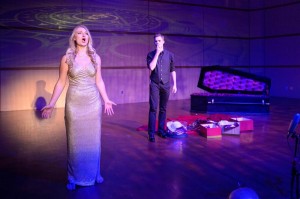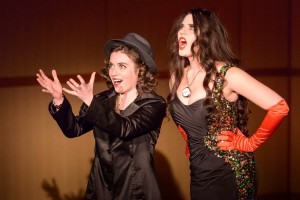WESTMINSTER COLLEGE OPERA STUDIO, Semele, Vieve Gore Concert Hall, Westminster College, 7:30 p.m. Jan. 23-24; tickets at 801-832-2457 or www.westminstercollege.edu/culturalevents
Headed by Michael Chipman, the fledgling Westminster College Opera Studio is certainly ambitious. Only in its fourth year, it has steadily progressed and improved to the point where it’s a worthy addition to the Wasatch Front’s vibrant collegiate operatic scene.
This weekend the Opera Studio presents George Frideric Handel’s 1743 opera Semele. The staging is clever and the performances by the talented young singers is spectacular. With this production, the opera program at Westminster has finally come into its own.
Handel’s final opera, Semeledeals with the ill-fated love affair between the title character and Jupiter. It opens with Semele’s impending marriage to Athamas, although she’s really in love with Jupiter. She asks for the god’s help; he hears her prayer and disrupts the wedding ceremony and has her carried off to a palace guarded by dragons.
Juno, Jupiter’s wife, is, of course, furious that her husband has a lover, and she vows revenge on Semele. Juno appears to Semele disguised as her sister, Ino, and convinces her to beg Jupiter to make her immortal. While at first balking at the idea, Jupiter finally relents, but reluctantly, knowing full well that doing so would actually be Semele’s demise, since no mortal can ever aspire to immortality.
What Chipman has done with the story is add a neat twist. Instead of setting it in mythological times, he’s updated the action. In Chipman’s reimagining, it now takes place in the Deep South and turns Jupiter, Juno and their cohorts into vampires. In this version, Semele achieves immortality by being bitten by Jupiter and becoming a vampire. Her death occurs as she awakens and emerges from her coffin, exposing herself to the rays of the bright sun.
It works, and it works in stunning fashion. Chipman has created an atmospheric, Goth world of sexy vampires. This eerie world juxtaposes stunningly with that of the mortals. Props are minimal but used to great effect, and the staging is aided by well chosen images that are projected on the wall behind the singers.
But this is opera, and opera, when all is said and done, comes down to the singers. And the cast that Chipman has assembled really delivers the goods.
Reichel Recommends attended Wednesday’s dress rehearsal. It was impressive how the singers embraced their roles and brought conviction and definition to their characters and brought the opera to life.
Standing out among the many fine young voices was soprano Christy Lee Peterson in the title role. Her portrayal had depth and was wonderfully delineated with finely crafted expressions. Her voice has a lovely suppleness to it that allows her to sing the florid lines with agility.
Soprano Asha Crandall, as Juno, also brought richness to her characterization. She, too, has the kind of voice that lets her sing florid lines with ease. She sang with lyricism and well defined expressiveness.
Among the men, tenor Alexander Blankers, as Jupiter, showed he has the right kind of voice for baroque opera. His is a light, fluid voice that generally projects well and has depth to it.
Baritone Christopher Stockslager, as Athamas, has a wonderfully warm sounding and well rounded voice. It is delightfully lyrical and expressive.
In smaller roles, mezzo-soprano Keri Hale (Ino), soprano Sally Drutman (Iris) and baritone Nick Metos (Somnus) were exceptional. They all have strong voices that are wonderfully inflected and rich with lyricism.
Rounding out the cast are Tanner Gilgen (Cadmus, Semele’s father), Jonah Hoskins (Apollo) and Ryan Hansen (Priest). All gave notable performances.
The small chorus was memorable; their voices blended well together, and they brought a lot to the production.
In addition to their vocal talents, the cast also showed they are actors of considerable merit. Their acting chops were solid and added to the overall depth they brought to their character portrayals.
Accompanying the singers is a small ensemble consisting of string quartet (Gerald Elias and Leslie Henrie, violins; Katie Bradford, viola; Cassie Olson, cello); harpsichord (Emily Williams); and timpani (Abby Scott). This arrangement of the score was made by the conductor Eric Schmidt, who elicited wonderfully nuanced playing from his band and also achieved a good balance between the singers and instrumentalists.
Chipman’s direction was dynamic, taut and well paced; it moved the action along at a good clip. The dramatic flow was also helped by the fact that Chipman cut out large sections of the opera, but without compromising the integrity of the storyline. In this version, it runs approximately 2 1/2 hours.
This production of Semele, which is ostensibly its Utah premiere, should be on every opera lover’s must see list this weekend. It won’t disappoint.



